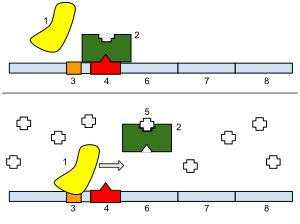
Back مثبط (وراثة) Arabic Represor (genetika) BS Represe (genetika) Czech Repressor German Represor (genética) Spanish سرکوبگر Persian Répresseur French Represor Galician Represor (genetika) Croatian Repressore Italian

In molecular genetics, a repressor is a DNA- or RNA-binding protein that inhibits the expression of one or more genes by binding to the operator or associated silencers. A DNA-binding repressor blocks the attachment of RNA polymerase to the promoter, thus preventing transcription of the genes into messenger RNA. An RNA-binding repressor binds to the mRNA and prevents translation of the mRNA into protein. This blocking or reducing of expression is called repression.